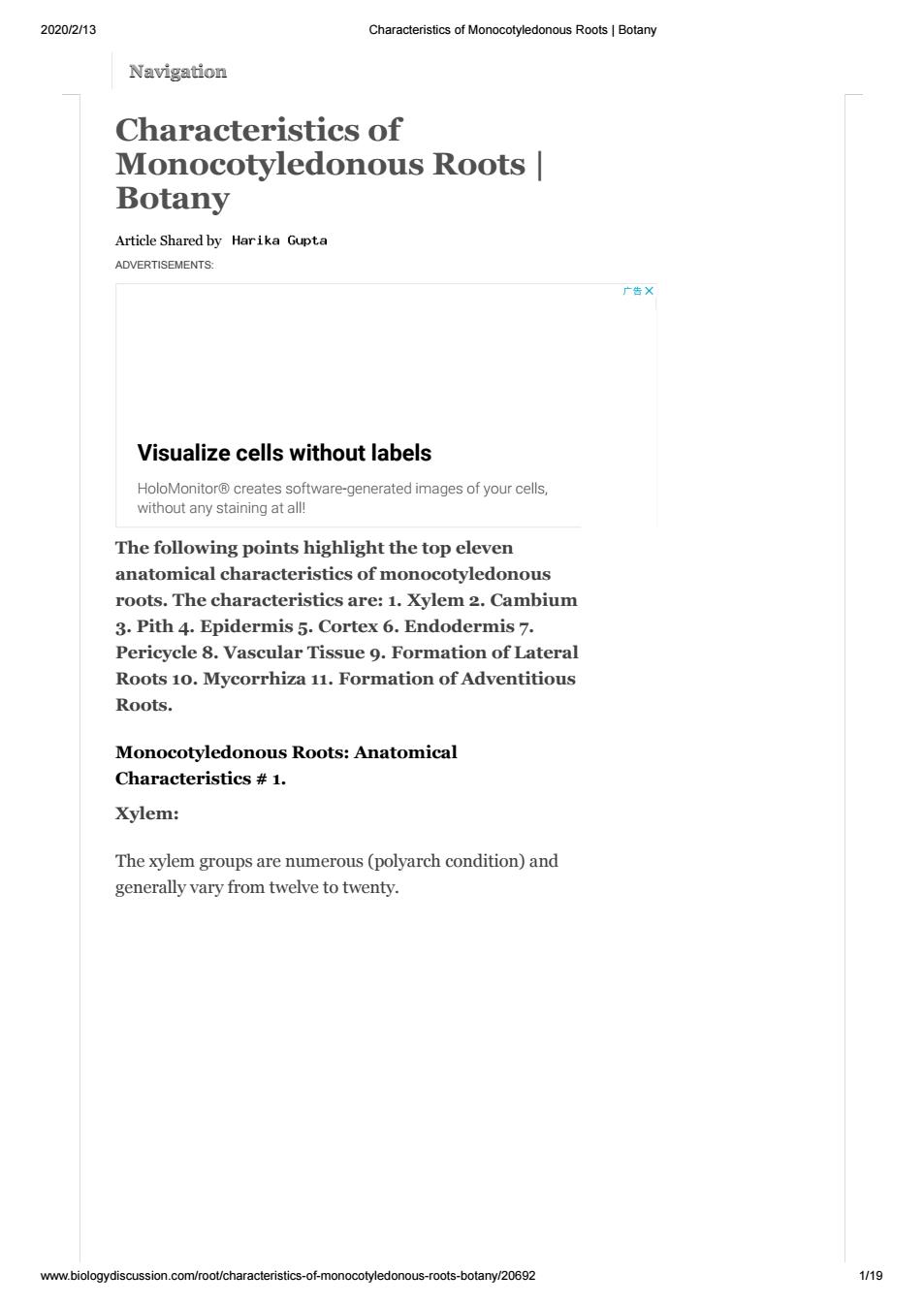
2020/2/13CharacteristicsofMonocotyledonousRootsBotanyNavigationCharacteristics ofMonocotyledonousRootsBotanyArticle Sharedby Harika GuptaADVERTISEMENTS:广告XVisualizecellswithout labelsHoloMonitor?creates software-generated imagesofyourcellswithout any stainingatall!Thefollowingpointshighlightthetopelevenanatomicalcharacteristics ofmonocotyledonousroots.The characteristics are: 1.Xylem 2. Cambium3.Pith4.Epidermis 5.Cortex 6.Endodermis 7.Pericycle 8.Vascular Tissue 9.Formation of LateralRoots1o.Mycorrhiza11.FormationofAdventitiousRoots.Monocotyledonous Roots:AnatomicalCharacteristics # 1.Xylem:The xylem groups are numerous (polyarch condition)andgenerally vary from twelve to twenty.www.biologydiscussion.com/root/characteristics-of-monocotyledonous-roots-botanyr206921/19
2020/2/13 Characteristics of Monocotyledonous Roots | Botany www.biologydiscussion.com/root/characteristics-of-monocotyledonous-roots-botany/20692 1/19 Navigation Characteristics of Monocotyledonous Roots | Botany Article Shared by ADVERTISEMENTS: The following points highlight the top eleven anatomical characteristics of monocotyledonous roots. The characteristics are: 1. Xylem 2. Cambium 3. Pith 4. Epidermis 5. Cortex 6. Endodermis 7. Pericycle 8. Vascular Tissue 9. Formation of Lateral Roots 10. Mycorrhiza 11. Formation of Adventitious Roots. Monocotyledonous Roots: Anatomical Characteristics # 1. Xylem: The xylem groups are numerous (polyarch condition) and generally vary from twelve to twenty. Visualize cells without labels HoloMonitor® creates software-generated images of your cells, without any staining at all!
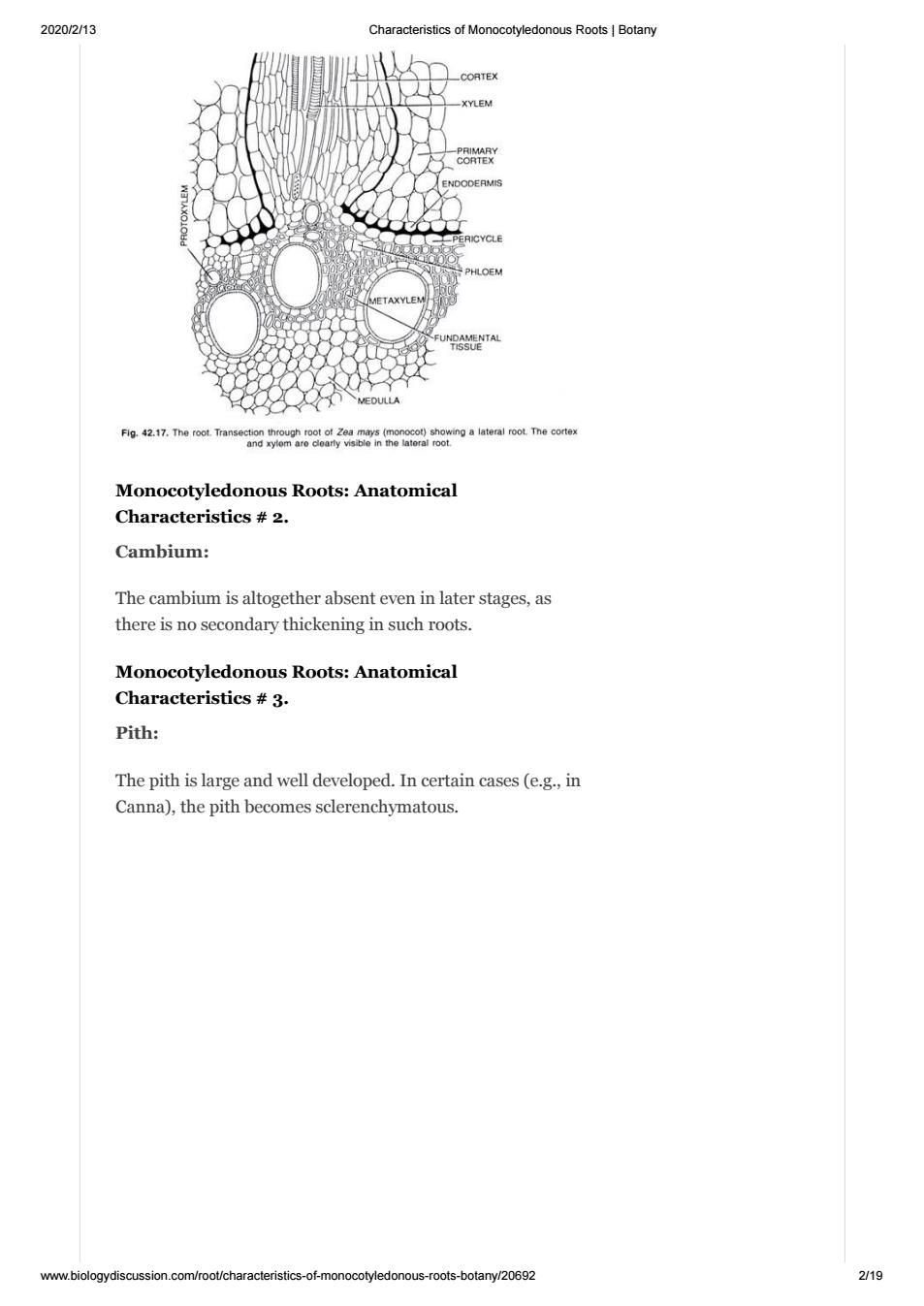
2020/2/13Characteristics of Monocotyledonous RootsBotanyCORTEXXYLEMBIMACORTEXENDODERMISRICYCLEPHLOEMENTALJEDIFig.42.17.Theroot.Transectionthroughrootof Zeamays (monocot)showing a lateral root.Tnecortexand xylem are clearly visible in the lateral root.MonocotyledonousRoots:AnatomicalCharacteristics#2.Cambium:Thecambium isaltogether absenteven inlater stages,asthereisno secondarythickening in such roots.Monocotyledonous Roots:AnatomicalCharacteristics # 3.Pith:The pith is large and well developed. In certain cases (e.g., inCanna), the pith becomes sclerenchymatous.2/19www.biologydiscussion.com/root/characteristics-of-monocotyledonous-roots-botany/20692
2020/2/13 Characteristics of Monocotyledonous Roots | Botany www.biologydiscussion.com/root/characteristics-of-monocotyledonous-roots-botany/20692 2/19 Monocotyledonous Roots: Anatomical Characteristics # 2. Cambium: The cambium is altogether absent even in later stages, as there is no secondary thickening in such roots. Monocotyledonous Roots: Anatomical Characteristics # 3. Pith: The pith is large and well developed. In certain cases (e.g., in Canna), the pith becomes sclerenchymatous
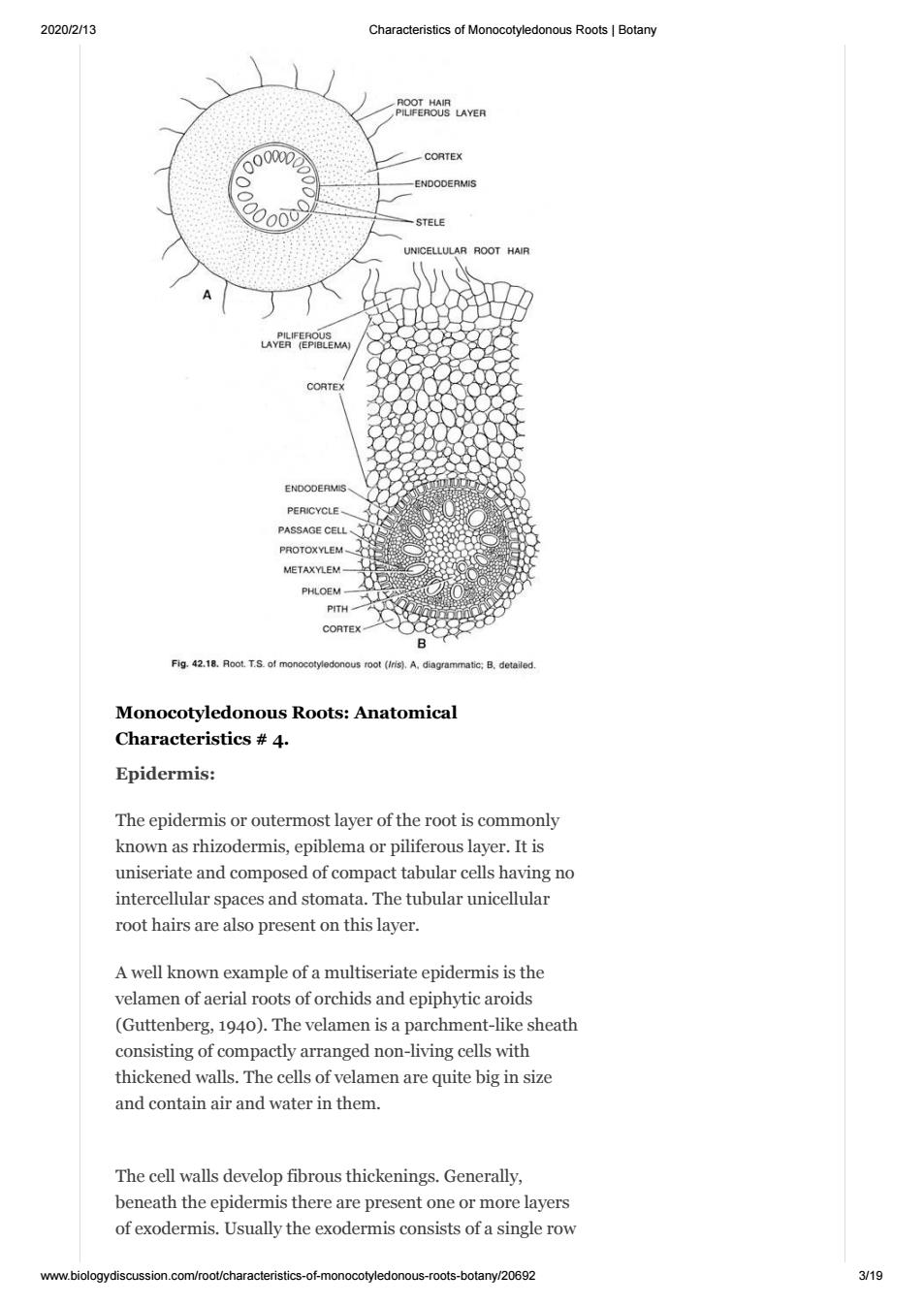
2020/2/13CharacteristicsofMonocotyledonousRootsBotanyUSLAYERCORTEXENDODERMISSTELEUNICELLULARROOTHAIRLAYER(EPIBLEMACORTEXENDODPERICYCLEPASSAGECELLPROTOXYLEMMETAXYLENPHLOENPITHCORTEX:Fig.42.18.Root.T.S.ofmonocotyledonous root (iris),A, diagrammatic; B,detailedMonocotyledonousRoots:AnatomicalCharacteristics # 4.Epidermis:The epidermis or outermost layer of the root is commonlyknown as rhizodermis,epiblema orpiliferouslayer.Itisuniseriate and composed of compact tabular cells having nointercellular spaces and stomata.The tubular unicellularroot hairs arealsopresent on thislayer.Awellknownexampleofamultiseriateepidermisisthevelamenof aerial rootsof orchidsandepiphyticaroids(Guttenberg, 1940). The velamen is a parchment-like sheathconsistingofcompactlyarrangednon-livingcellswiththickened walls.The cells of velamen are quite big in sizeand containairandwaterinthem.Thecellwallsdevelopfibrousthickenings.Generallybeneath the epidermisthere are present one ormore layersofexodermis.Usuallytheexodermisconsistsofasinglerowwww.biologydiscussion.com/root/characteristics-of-monocotyledonous-roots-botany/206923/19
2020/2/13 Characteristics of Monocotyledonous Roots | Botany www.biologydiscussion.com/root/characteristics-of-monocotyledonous-roots-botany/20692 3/19 Monocotyledonous Roots: Anatomical Characteristics # 4. Epidermis: The epidermis or outermost layer of the root is commonly known as rhizodermis, epiblema or piliferous layer. It is uniseriate and composed of compact tabular cells having no intercellular spaces and stomata. The tubular unicellular root hairs are also present on this layer. A well known example of a multiseriate epidermis is the velamen of aerial roots of orchids and epiphytic aroids (Guttenberg, 1940). The velamen is a parchment-like sheath consisting of compactly arranged non-living cells with thickened walls. The cells of velamen are quite big in size and contain air and water in them. The cell walls develop fibrous thickenings. Generally, beneath the epidermis there are present one or more layers of exodermis. Usually the exodermis consists of a single row
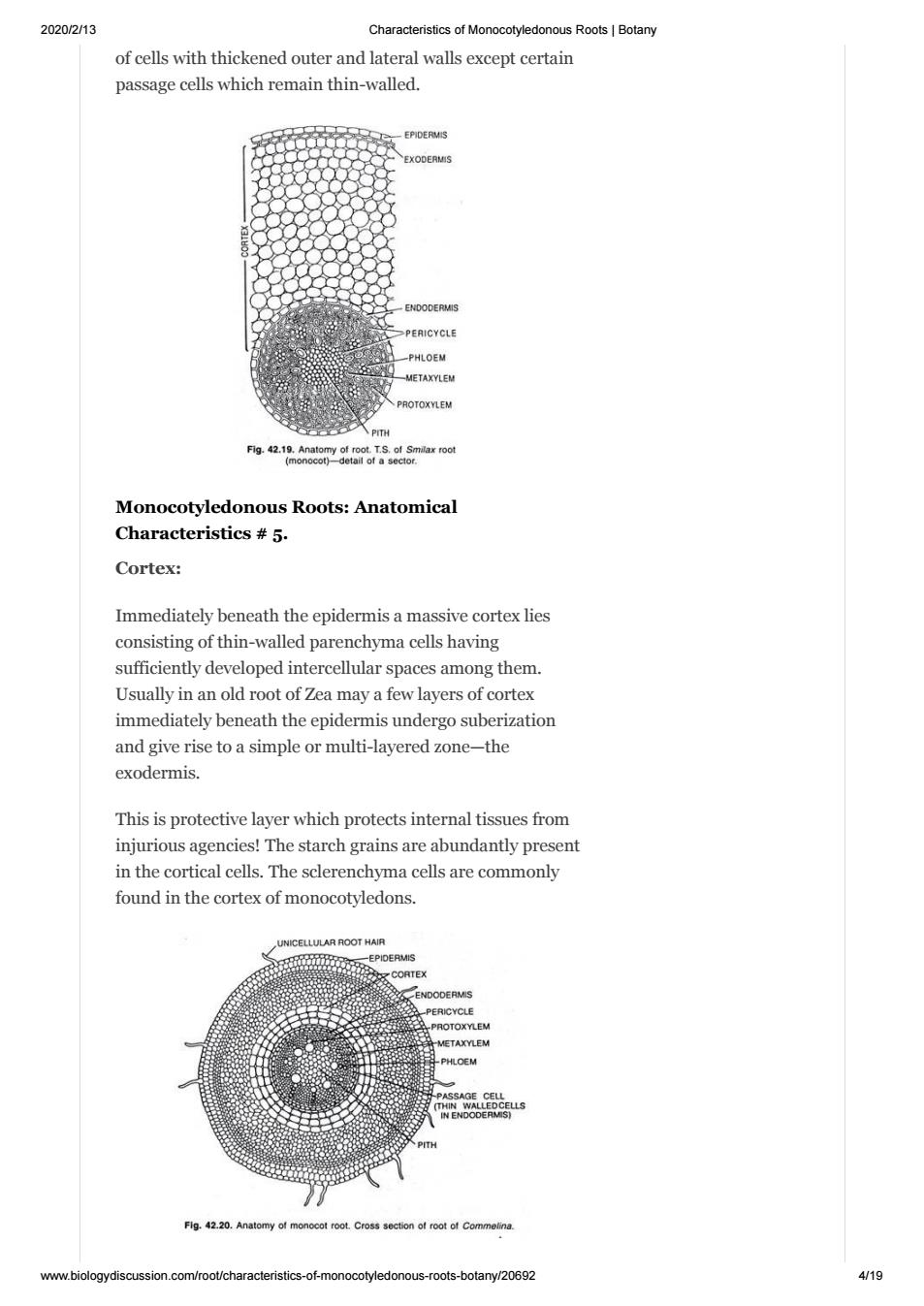
2020/2/13Characteristics of Monocotyledonous Roots Botanyof cells withthickened outer and lateral walls except certainpassagecells which remain thin-walled.EPIDERMISEXODERMISENDODERMISPERICYCLEPHLOEMMETAXYLEMPROTOXYLEMITHFig.42.19.Anatomyofroott.T.S.of.Smilaxroof(monocot)-detail of asectorMonocotyledonousRoots:AnatomicalCharacteristics # 5.Cortex:Immediatelybeneaththeepidermisamassivecortexliesconsisting of thin-walled parenchyma cells havingsufficientlydeveloped intercellular spaces amongthem.Usually in an old root of Zea may a few layers of corteximmediatelybeneaththeepidermisundergosuberizationandgiverisetoa simpleormulti-layered zone-theexodermis.Thisisprotectivelayerwhichprotectsinternaltissuesfrominjurious agencies!The starch grains are abundantlypresentinthecorticalcells.Thesclerenchymacellsarecommonlyfound inthe cortex ofmonocotyledons.JNICELLULARROOTHAIREPIDERMISCORTEXENDODERMISPERICYCLEPROTOXYLEMETAXYLEMPHLOEMASSAGECELLTHINWALLEDCELLSINENDODERMIS)Fig.42.20.Anatomyofmonocotroot.CrosssectionolrootofCommelina.www.biologydiscussion.com/root/characteristics-of-monocotyledonous-roots-botanyr206924/19
2020/2/13 Characteristics of Monocotyledonous Roots | Botany www.biologydiscussion.com/root/characteristics-of-monocotyledonous-roots-botany/20692 4/19 of cells with thickened outer and lateral walls except certain passage cells which remain thin-walled. Monocotyledonous Roots: Anatomical Characteristics # 5. Cortex: Immediately beneath the epidermis a massive cortex lies consisting of thin-walled parenchyma cells having sufficiently developed intercellular spaces among them. Usually in an old root of Zea may a few layers of cortex immediately beneath the epidermis undergo suberization and give rise to a simple or multi-layered zone—the exodermis. This is protective layer which protects internal tissues from injurious agencies! The starch grains are abundantly present in the cortical cells. The sclerenchyma cells are commonly found in the cortex of monocotyledons
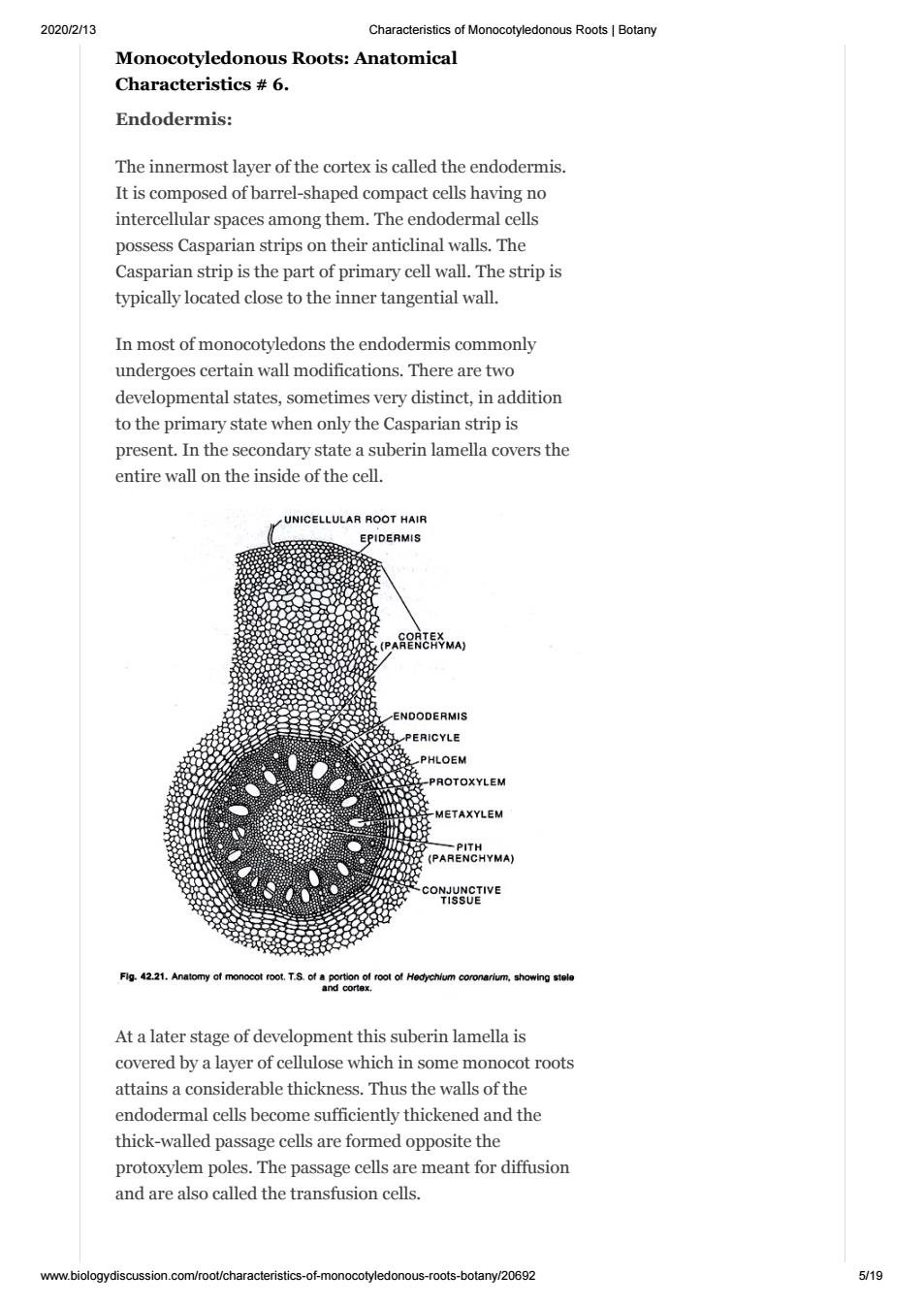
2020/2/13Characteristics of Monocotyledonous Roots BotanyMonocotyledonousRoots:AnatomicalCharacteristics#6.Endodermis:TheinnermostlayerofthecortexiscalledtheendodermisIt is composed of barrel-shaped compact cells having nointercellular spaces among them. The endodermal cellspossess Casparian strips on their anticlinal walls. TheCasparianstripisthepart of primary cell wall.The stripistypicallylocated close tothe innertangential wall.Inmostofmonocotyledonstheendodermiscommonlyundergoescertainwallmodifications.Therearetwodevelopmental states, sometimes very distinct, in additiontotheprimarystatewhenonlytheCasparianstripispresent. In the secondary state a suberin lamella covers theentirewall ontheinsideofthecell.JNICELLULARROOTHAIREPIDERMISGENTHYMAYENDODERMISPERICYLEPHLOEMPROTOXYLEMMETAXYLEMTPARENCHYMAUNCTIVETISSUEFig.42.21.AnaAt a later stage of development this suberin lamella iscovered by a layer of cellulose which in some monocot rootsattains a considerablethickness.Thus the walls of theendodermalcellsbecomesufficientlythickenedandthethick-walled passage cells are formed opposite theprotoxylempoles.Thepassage cellsaremeantfordiffusionand are also called the transfusion cells.www.biologydiscussion.com/root/characteristics-of-monocotyledonous-roots-botany/206925/19
2020/2/13 Characteristics of Monocotyledonous Roots | Botany www.biologydiscussion.com/root/characteristics-of-monocotyledonous-roots-botany/20692 5/19 Monocotyledonous Roots: Anatomical Characteristics # 6. Endodermis: The innermost layer of the cortex is called the endodermis. It is composed of barrel-shaped compact cells having no intercellular spaces among them. The endodermal cells possess Casparian strips on their anticlinal walls. The Casparian strip is the part of primary cell wall. The strip is typically located close to the inner tangential wall. In most of monocotyledons the endodermis commonly undergoes certain wall modifications. There are two developmental states, sometimes very distinct, in addition to the primary state when only the Casparian strip is present. In the secondary state a suberin lamella covers the entire wall on the inside of the cell. At a later stage of development this suberin lamella is covered by a layer of cellulose which in some monocot roots attains a considerable thickness. Thus the walls of the endodermal cells become sufficiently thickened and the thick-walled passage cells are formed opposite the protoxylem poles. The passage cells are meant for diffusion and are also called the transfusion cells